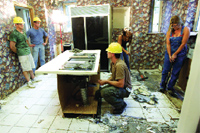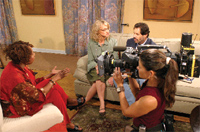Among its on-going projects, West Post Digital is finishing two reality TV series - Extreme Makeover: The Home Edition and How'd They Do That? Designed as companion series, Extreme Makeover: The Home Edition focuses on the story of a family in desperate need of home renovations (such as a family with a handicapped son who needed the home to be wheelchair accessible); while How'd They Do That? focuses on the work done by hundreds of carpenters who must complete the renovation in one week.

The Mansion was edited at Fotokem. As much as 1,500 hours of footage was captured for the first seven shows.
|
"We've been given a directive from the production company, Lock and Key Productions (Mike Malloy, supervising producer), that their shows are to be the highest quality they can be, and they have demonstrated this commitment by making creative changes to the show up to the very end," explains Fields.
The production has been using Sony IMX (MPEG) for acquisition, which Fields says, "is as good or better than Betacam SP but without the dropouts. Dropouts are very time-consuming to fix, so this format gives us one less problem to worry about. Recently, the production switched to Sony's XDCAM (disk-based) format, so our online editors will have random access to any clips as opposed to shuttling back and forth on tapes. With 200 to 300 tapes and 1,500 cuts per show, jumping from one timecode to another instantly saves a tremendous amount of time."
Rather than color correcting on the Symphony, West Post Digital moves the project to its color correction bay where colorist Randy Starnes (Desperate Housewives) does the color timing on a da Vinci 2K. Fields says, "This is the highest quality tool for color timing and the most efficient way to go. And this frees up our Symphony systems for building the graphics and titling to keep the project moving forward."

Bunim-Murray uses Avid Meridien Media Composers to put together Starting Over.
|
QUEER EYE FOR THE STRAIGHT GUY
For each one-hour episode of Queer Eye for the Straight Guy seen weekly on Bravo, "We have to watch about 30 hours of footage to make sure we've explored all the options to tell the story clearly and concisely," says Michael LaHaie, senior editor for Queer Eye for the Straight Guy, which is edited at PostWorks/NY and produced by Scout Productions, in Boston.
Queer Eye unleashes the "Fab Five" - Ted Allen, Kyan Douglas, Thom Felicia, Carson Kressley and Jai Rodriguez - in an effort to improve a straight guy's lifestyle.
The first of the show's five acts is the "destraightening," where the Fab Five assess the straight guy's unique problems and goals. In act two, they go shopping, to the hair salon, the gym, or anywhere necessary services can be obtained. In act three, they return to the straight guy's house and show-off his new look and lifestyle. In acts four and five, the straight guy invites family and friends to witness his total makeover while the Fab Five watch video of his activities and comment on his performance.
"Act one is the most difficult to edit because the Fab Five are running into different rooms, pulling things out of closets, and talking over one another in their zeal to get things going," says LaHaie. "We watch the scenes in multi-cam mode or individually on an Avid Symphony, as well as listen to each person's audio recorded onto a DA-88 recorder during shooting to find the story beats." The staff includes five editors sharing footage on an Avid Unity system and three assistant editors who load, group and synch footage into Unity.
"The strategy that gives this show its energy is the illusion that these events are taking place in one day. We avoid jump cuts, dissolves, voice-overs, and effects that betray that real-time pace," says LaHaie. "So, if the straight guy is in his living room talking to Carson while Kyan can be heard joking around in the background, then the shot you go to after that can't have any of those people in it. And because the combinations of people in the shots are always changing, it's a real puzzle finding those shots that maintain continuity while advancing the storyline."
THE MANSION
"Editing reality TV shows can be daunting, depending upon the delivery schedule, and how many rounds of reviews the team needs to do," says Sharon Morrissette, supervising producer for Evolution Film and Tape (www.evolutionusa.com/) in Burbank, CA, which produced The Mansion for TBS. "In the case of The Mansion, we send work in progress to executives at TBS, as well as our own production executives."
A home improvement reality show, The Mansion is set in Cincinnati on a three-acre estate where a 1926 mansion is in need of repair. Eight contestants - amateurs possessing home repair skills - compete on the basis of how well they performed various repair tasks at the mansion. The prize is the property itself. Shown on TBS last Fall, The Mansion was comprised of eight weekly, one-hour episodes, with the final one taped in a broadcast style, as if it were live.
"The first seven episodes included footage of the contestants renovating the house, as well as 'on-the-fly' interviews with each contestant talking about their working relationships and conflicts during the contest," says Morrissette.
The shows were shot ENG-style using Sony's XDCAM disk-based camcorders, which record to Sony PFD-23 Professional Disc media. This footage was bumped to Sony IMX media for ingestion into an Avid Unity serving several Avid Symphonies.
"For the first seven shows, we shot 1,500 hours of footage, and had eight editors sharing nearly 3.5 TB on Unity," notes Morrissette. "We also had eight 'loggers' using Pilot's PilotWare logging software to log and track video assets." Editing took place at Fotokem in Burbank.
COLD TURKEY
Cold Turkey is the only reality show where the story producers view raw footage, and put together a rough edit rather than just a "paper cut."
"The benefit is that our story producers can flesh out the stories before it ever gets into the editor's hands, saving untold hours of editing," explains Rob Claridge, post producer and supervising editor of the show. Cold Turkey, which airs on Pax TV, is edited at Visual Frontier (www.visualfrontier.com/), a production company in Los Angeles. Visual Frontier's John Holmes is executive producer in association with Stuart Krakow of Stuart Krakow Productions, Los Angeles.
The innovative editing set-up includes five Avid Meridien Media Composer 9000 systems and six Avid Xpress DV Pro stations connected via an Avid LANshare EX network to an Avid Unity with 3 TB of shared storage.
"Our story producers can view clips in low-res from laptops, and string them together," says Claridge. "I can import their segments into my Media Composer and finish them into one-hour weekly shows."
The premise of Cold Turkey is that 10 smokers are lured to a house under the false pretense that they would be participating in a reality show to win whatever they wanted most - to drive a NASCAR stock car or to travel into space with NASA. "But, in the first episode, our host AJ Benza, revealed the truth - that they were going to go 'cold turkey' and not smoke for 24 days. Their reaction to this news was priceless," says Claridge. While they were given the choice to leave, all of the contestants chose to stay.
"Editing reality TV is a great challenge because each show has to be compelling to new viewers and stand on its own," says Claridge. "And you have to sift through thousands of hours of footage and come up with a captivating story that fits into a concise format.
"If you can edit reality TV," says Claridge, "you can edit anything.